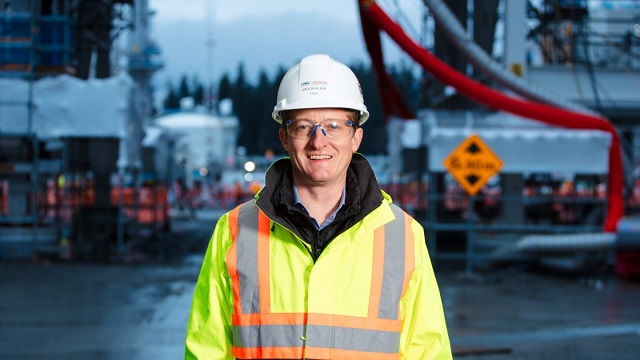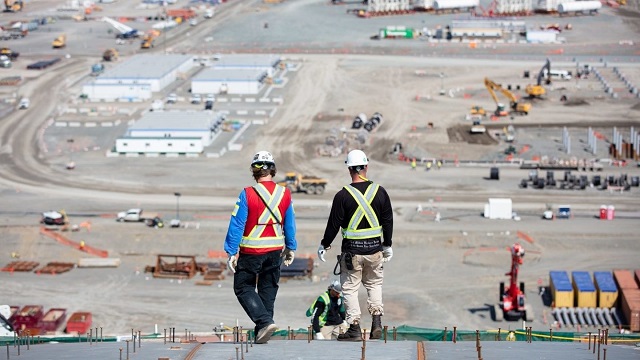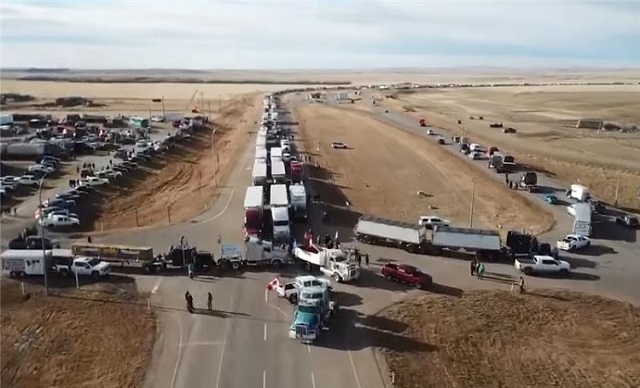Canadian Energy Centre
B.C. expects doubling of natural gas revenues with startup of LNG Canada

LNG Canada CEO Jason Klein. Photo courtesy LNG Canada
From the Canadian Energy Centre
By Deborah JaremkoRoyalties help pay for public services like health care, hospitals, education and schools
As Canada’s first LNG export terminal prepares for start-up, British Columbia is preparing for an influx of new revenues that will help fund government programs.
With the LNG Canada project online – expected by mid-2025 – the province expects proceeds from natural gas development will more than double.
The anticipated production of LNG by the middle of this decade boosts the province’s financial outlook, the government said in its Budget 2024.
For LNG Canada CEO Jason Klein, the coming start-up is “the launch of an entirely new Canadian industry.”
It will enable Canada’s first large-scale exports of natural gas to somewhere other than the United States.
Shipments will primarily go to Asia, where demand is expected to increase by more than 50 per cent over the next three decades, according to the U.S. Energy Information Administration.
While it’s a little over one year before the first LNG carrier will set sail through the Douglas Channel to the ocean, Klein noted the benefits are already being felt.
“More than 30,000 Canadians have worked on our project to date, with almost 9,000 Canadians employed at our Kitimat site in January this year alone,” he said.
“The cumulative value of our project’s contracts and subcontracts to local, Indigenous and other businesses in B.C. has already exceeded $4.7 billion and includes more than $3.8 billion to Indigenous-owned and local area businesses.”
Natural gas royalties paid to the province, which help pay for public services and facilities such as health care, hospitals, education and schools, are expected to rise substantially.
This year, the B.C. government expects $684 million in natural gas royalties, according to its latest annual budget. In 2027, once LNG Canada is operational, this is forecast to surge to $1.4 billion.
Globally, LNG is playing an increasingly important role in energy supply, with demand set to continue growing beyond 2040, according to Shell’s latest industry outlook.
China is likely to dominate rising LNG demand as the country’s industries look to cut carbon emissions by switching from coal to gas.
Once operational, LNG Canada will demonstrate the low-emissions advantage of Canada’s LNG supply.
“We’ve designed a project with the lowest carbon intensity of any large-scale LNG export facility operating today,” Klein said.
“[It will have] emissions that are 35 per cent lower than the world’s best performing facilities and 60 per cent lower than the global weighted average.”
Alberta
Start-up of Trans Mountain expansion ‘going very well’ as global buyers ink deals for Canadian crude

A worker at Trans Mountain’s Burnaby Terminal. Photo courtesy Trans Mountain Corporation
From the Canadian Energy Centre
Chinese refiner pays about US$10 more for oil off TMX compared to sales value in Alberta
Canada’s oil sands producers are “back in the limelight” for investors following completion of the Trans Mountain pipeline expansion, according to a report by Enervus Intelligence Research.
For the first time in the better part of a decade, there is now breathing room on the system to ship all of the oil producers are able to sell off the coast of B.C.
Up until this May, Trans Mountain was regularly overbooked. Not anymore.
The crude carrier Dubai Angel picked up the first shipment from the long-awaited expansion on May 22, setting sail for China and a customer of oil sands producer Suncor Energy.
Analysts estimate Trans Mountain loaded 20 vessels in June, compared to a pre-expansion average of five per month.
“You’re seeing multiple buyers. It’s going very well,” said Phil Skolnick, managing director of research with New York-based Eight Capital.
“You’re seeing the exact buyers that we always thought were going to show up, the U.S. west coast refineries and as well as the Asian refineries, and there was a shipment that went to India as well.”
 The “Golden Weld” in April 2024 marked the mechanical completion and end of construction for the Trans Mountain expansion project. Photo courtesy Trans Mountain Corporation
The “Golden Weld” in April 2024 marked the mechanical completion and end of construction for the Trans Mountain expansion project. Photo courtesy Trans Mountain Corporation
Canadian crude in demand on the global market
Asian markets – particularly China, where refineries can process “substantial quantities” of extra heavy crude and bitumen – are now “opened in earnest” to Canadian oil, the International Energy Agency (IEA) said in its June Oil 2024 report.
“There’s demand for this crude and people are going to make deals,” said Kevin Birn, chief analyst of Canadian oil markets with S&P Global.
The IEA said Canadian crude will increasingly compete with heavy oil from other countries, particularly those in Latin America and the Middle East.
June’s loading of 20 vessels is slightly lower than the 22 vessels Trans Mountain had targeted, but Skolnick said a few bumps in the project’s ramp-up are to be expected.
“About three months ago, the shippers were telling investors on their calls, don’t expect it to be a smooth ramp up, it’s going to be a bit bumpy, but I think they’re expecting by Q4 you should start seeing everyone at peak rates,” Skolnick said.
Delivering higher prices
Trans Mountain’s expanded Westridge Terminal at Burnaby, B.C. now has capacity to load 34 so-called “Aframax” vessels each month.
One of the first deals, with Chinese refiner Rongsheng Petrochemical, indicates the Trans Mountain expansion is delivering on one of its expected benefits – higher prices for Canadian oil.
Canada’s Parliamentary Budget Office has said that an increase of US$5 per barrel for Canadian heavy oil over one year would add $6 billion to Canada’s economy.
The June deal between Rongsheng and an unnamed oil sands shipper saw a shipment of Access Western Blend (AWB) purchased for approximately US$6 per barrel below the Brent global oil benchmark. That implies an AWB selling price of approximately US$75 per barrel, or about US$10 more than the price received for AWB in Alberta.
 Expanded export capacity at the Trans Mountain Westridge Terminal. Photo courtesy Trans Mountain Corporation
Expanded export capacity at the Trans Mountain Westridge Terminal. Photo courtesy Trans Mountain Corporation
More pipeline capacity needed
Oil sands production – currently about 3.4 million barrels per day – is projected to rise to 3.8 million barrels per day by the end of the decade before declining slightly to about 3.6 million barrels per day in 2035, according to the latest outlook by S&P Global.
“Despite the recent completion of the Trans Mountain Expansion project, additional capacity will still be needed, likely via expansion or optimization of the existing pipeline system,” wrote Birn and S&P senior research analyst Celina Hwang in May.
“By 2026, we forecast the need for further export capacity to ensure that the system remains balanced on pipeline economics.”
Uncertainty over the federal government’s proposed oil and gas emissions cap “adds hesitation” to companies considering large-scale production growth, wrote Birn and Hwang.
Global oil demand rising
World oil demand, which according to the IEA reached a record 103 million barrels per day in 2023, is projected to continue rising despite increased investment in renewable and alternative energy.
A June outlook by the International Energy Forum (IEF) pegs 2030 oil demand at nearly 110 million barrels per day.
“More investment in new oil and gas supply is needed to meet growing demand and maintain energy market stability, which is the foundation of global economic and social well-being,” said IEF secretary Joseph McMonigle.
Canadian Energy Centre
What’s next? With major projects wrapping up, what does Canada’s energy future hold

From the Canadian Energy Centre
By Mario Toneguzzi‘This is the first time Canada will enter the global marketplace as a global player, so it is an incredibly important change for the industry’
With the recent completions of the Trans Mountain expansion and Coastal GasLink pipelines, and the looming completion of LNG Canada within the next year, there are few major energy projects with the green light for one of the world’s largest and most responsible energy producers.
Which leaves a lingering question: In a world that has put a premium on energy security, what’s next for Canada?
Heather Exner-Pirot, a senior fellow and director of the natural resources, energy and environment program at the Macdonald-Laurier Institute, said Natural Resources Canada’s major projects inventory “has been in a pretty sharp decline since 2015, which is concerning.”
“It’s not just oil and gas but also mining, also electricity . . . It’s the overall context for investment in Canada,” said Exner-Pirot, who is also a special adviser to the Business Council of Canada.
“When we look at BC, we see TMX, Coastal GasLink, very soon LNG Canada will be finishing up. That’s probably in the order of $100 billion of investment that that province will lose.
“So you do start to think about what happens next. But there are some things on the horizon. I think that’s part of it. Other LNG projects where maybe it wasn’t politically popular, it wasn’t a social license, and maybe the labour force was also constrained, and now is opening opportunities.”
A recent analysis conducted by Exner-Pirot found that between 2015 and 2023, the number of energy and natural resource major projects completed in Canada dropped by 37 per cent. And those that managed to be completed often faced significant delays and cost overruns.
One notable project Exner-Pirot expects to fill the void is Ksi Lisims LNG, which is being developed on the northwest coast of Canada to export low-carbon LNG to markets in Asia. The project represents a unique alliance between the Nisga’a Nation, Rockies LNG and Western LNG.
Ksi Lisims LNG is a proposed floating LNG export facility located on a site owned by the Nisga’a Nation near the community of Gingolx in British Columbia.
The project will have capacity to produce 12 million tonnes of LNG per year, destined for markets in the Pacific basin, primarily in Asia where demand for cleaner fuels to replace coal continues to grow.
 Rendering of the proposed Ksi Lisims floating LNG project. Image courtesy Ksi Lisims LNG
Rendering of the proposed Ksi Lisims floating LNG project. Image courtesy Ksi Lisims LNG
As well, the second phase of the LNG Canada export terminal in Kitimat, B.C. shows increasing signs of moving forward, which would roughly double its annual production capacity from 14 million tonnes to 26 million tonnes, Exner-Pirot added.
While nearby, Cedar LNG, the world’s first Indigenous-owned LNG export facility, is closing in on the finish line with all permits in place and early construction underway. When completed, the facility will produce up to three million tonnes of LNG annually, which will be able to reach customers in Asia, and beyond.
According to the International Energy Agency, the world is on track to use more oil in 2024 than last year’s record-setting mark. Demand for both oil and natural gas is projected to see gradual growth through 2050, based on the most likely global scenario.
Kevin Birn, chief analyst for Canadian oil markets at S&P Global, said despite the Trans Mountain expansion increasing Canada’s oil export capacity by 590,000 barrels per day, conversations have already begun around the need for more infrastructure to export oil from western Canada.
“The Trans Mountain pipeline, although it’s critical and adds the single largest uplift in oil capacity in one swoop, we see production continue to grow, which puts pressures on that egress system,” he said.
 Photo courtesy Trans Mountain Corporation
Photo courtesy Trans Mountain Corporation
Birn said Canada remains a major global player on the supply side, being the world’s fourth-largest producer of oil and fifth-largest producer of natural gas.
“This is a really important period for Canada. These megaprojects, they’re generational. These are a once-in-a-generation kind of thing,” Birn said.
“For Canada’s entire history of being an oil and gas producer, it’s been almost solely reliant on one single export market, which is the United States. That’s been beneficial, but it’s also caused problems for Canada in that reliance from time to time.
“This is the first time Canada will enter the global marketplace as a global player, so it is an incredibly important change for the industry.”
Exner-Pirot said Canada has the ability to become a major exporter on the energy front globally, at a time when demand is accelerating.
“We have open water from B.C. to our allies in Asia . . . It’s a straight line from Canada to its allies. This is a tremendous advantage,” she said, noting the growth of data centres and AI is expected to see demand for reliable energy soar.
“We are seeing growing electricity demand after decades of plateauing because our fridges got more energy efficient and our washers and dryers got more energy efficient. Now we’re starting to see for the first time in a long time more electricity demand even in developed countries. These are all drivers.”
-

 Brownstone Institute1 day ago
Brownstone Institute1 day agoThe Media Refuses to Accept Covid Reality
-

 Alberta1 day ago
Alberta1 day ago‘Fireworks’ As Defence Opens Case In Coutts Two Trial
-

 National1 day ago
National1 day agoLiberals offer no response as Conservative MP calls Trudeau a ‘liar’ for an hour straight
-

 COVID-191 day ago
COVID-191 day agoLeaked documents: German gov’t lied about shots preventing COVID, knew lockdowns did more harm than good
-

 Business1 day ago
Business1 day agoFederal government seems committed to killing investment in Canada
-

 International1 day ago
International1 day agoSwitzerland’s new portable suicide ‘pod’ set to claim its first life ‘soon’
-

 Business1 day ago
Business1 day agoEstonia’s solution to Canada’s stagnating economic growth
-

 Economy1 day ago
Economy1 day agoKamala Harris’ Energy Policy Catalog Is Full Of Whoppers







